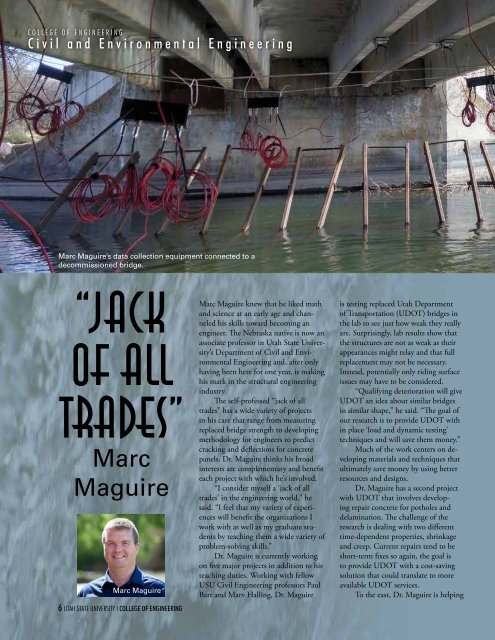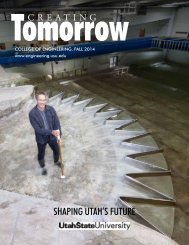Tomorrow
Create successful ePaper yourself
Turn your PDF publications into a flip-book with our unique Google optimized e-Paper software.
COLLEGE OF ENGINEERING<br />
Civil and Environmental Engineering<br />
Marc Maguire’s data collection equipment connected to a<br />
decommissioned bridge.<br />
“Jack<br />
of All<br />
Trades”<br />
Marc<br />
Maguire<br />
Marc Maguire<br />
6 UTAH STATE UNIVERSITY I COLLEGE OF ENGINEERING<br />
Marc Maguire knew that he liked math<br />
and science at an early age and channeled<br />
his skills toward becoming an<br />
engineer. The Nebraska native is now an<br />
associate professor in Utah State University’s<br />
Department of Civil and Environmental<br />
Engineering and, after only<br />
having been here for one year, is making<br />
his mark in the structural engineering<br />
industry.<br />
The self-professed “jack of all<br />
trades” has a wide variety of projects<br />
in his care that range from measuring<br />
replaced bridge strength to developing<br />
methodology for engineers to predict<br />
cracking and deflections for concrete<br />
panels. Dr. Maguire thinks his broad<br />
interests are complementary and benefit<br />
each project with which he’s involved.<br />
“I consider myself a ‘jack of all<br />
trades’ in the engineering world,” he<br />
said. “I feel that my variety of experiences<br />
will benefit the organizations I<br />
work with as well as my graduate students<br />
by teaching them a wide variety of<br />
problem-solving skills.”<br />
Dr. Maguire is currently working<br />
on five major projects in addition to his<br />
teaching duties. Working with fellow<br />
USU Civil Engineering professors Paul<br />
Barr and Marv Halling, Dr. Maguire<br />
is testing replaced Utah Department<br />
of Transportation (UDOT) bridges in<br />
the lab to see just how weak they really<br />
are. Surprisingly, lab results show that<br />
the structures are not as weak as their<br />
appearances might relay and that full<br />
replacement may not be necessary.<br />
Instead, potentially only riding surface<br />
issues may have to be considered.<br />
“Qualifying deterioration will give<br />
UDOT an idea about similar bridges<br />
in similar shape,” he said. “The goal of<br />
our research is to provide UDOT with<br />
in place ‘load and dynamic testing’<br />
techniques and will save them money.”<br />
Much of the work centers on developing<br />
materials and techniques that<br />
ultimately save money by using better<br />
resources and designs.<br />
Dr. Maguire has a second project<br />
with UDOT that involves developing<br />
repair concrete for potholes and<br />
delamination. The challenge of the<br />
research is dealing with two different<br />
time-dependent properties, shrinkage<br />
and creep. Current repairs tend to be<br />
short-term fixes so again, the goal is<br />
to provide UDOT with a cost-saving<br />
solution that could translate to more<br />
available UDOT services.<br />
To the east, Dr. Maguire is helping



